Congestion at Vancouver worsens – but it's not all the port's fault
Congestion at Canada’s west coast gateway of Vancouver is set to worsen in the coming ...

Waterborne Canadian imports from Asia remain under pressure. Traffic links between the port of Vancouver and the Canadian interior are gradually being restored after they were severed by severe flooding, but the situation remains tenuous and a full recovery of cargo flows is still a ...

Comment on this article